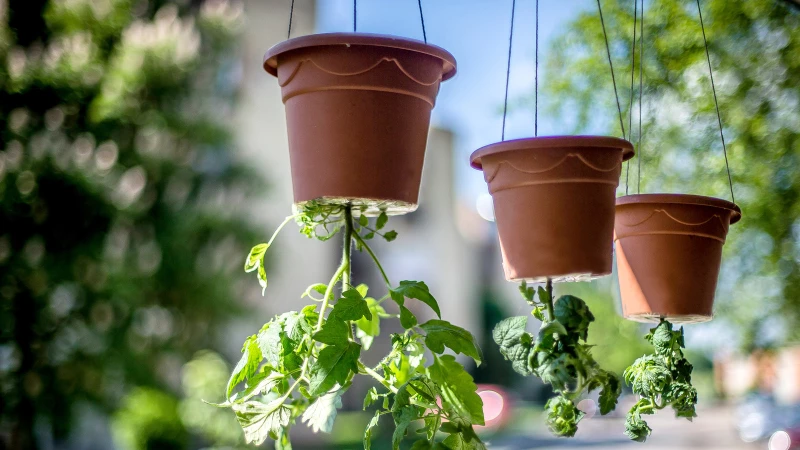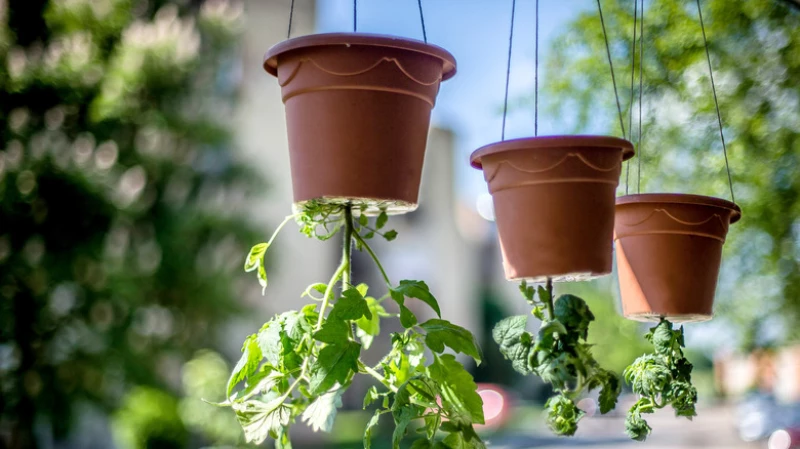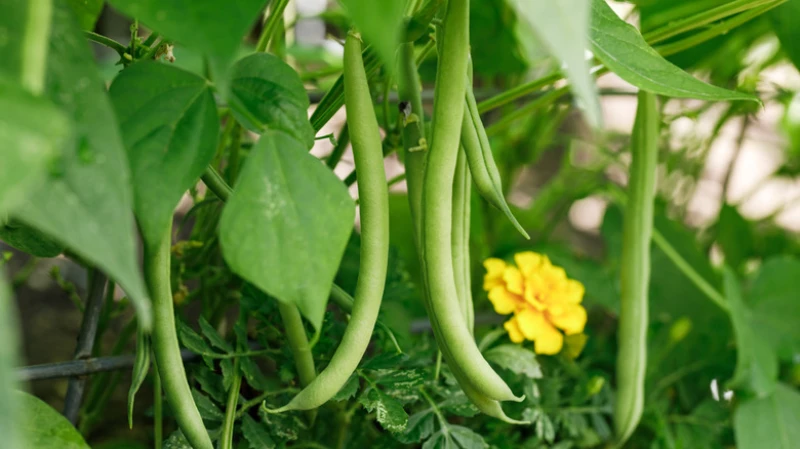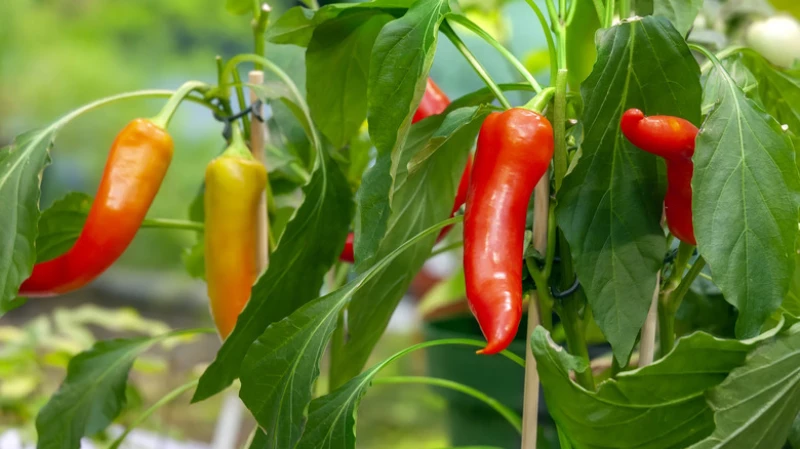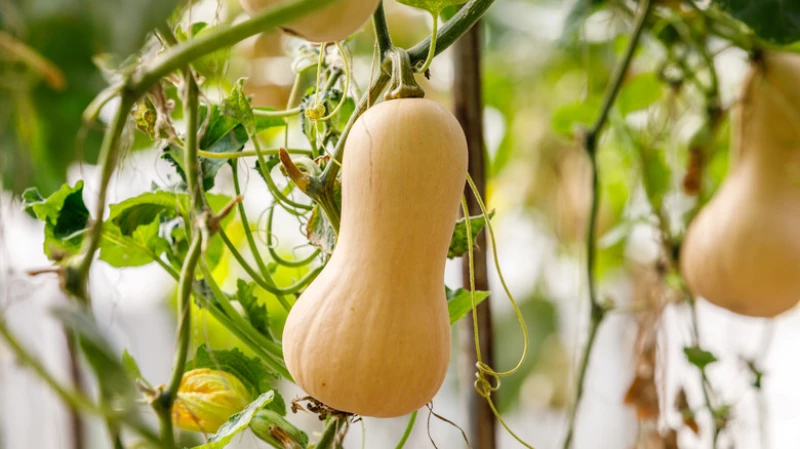The popularity of upside-down gardens has been increasing in recent years due to their uniqueness and numerous benefits. In this method, hanging flower pots with a hole in the center of the base are used to plant greens face down. Instead of the roots growing into the ground, they grow towards the sky. While unconventional, this gardening technique is ideal for small spaces, such as concrete yards or balconies, as it allows for fresh produce without the need for trellises or stakes. Additionally, the elevated pots help prevent fungus, pests, and weeds from attacking the vegetables. Here are seven of the best vegetables to plant upside down:
- Tomatoes
- Peppers
- Cucumbers
- Strawberries
- Beans
- Squash
- Eggplant
1. Tomatoes
Tomatoes are one of the best vegetables to grow upside down. They are relatively easy to grow and thrive in this unique gardening method. Upside-down tomato plants require less space and are less prone to diseases and pests. They also produce a higher yield compared to traditional tomato plants. To grow tomatoes upside down, simply plant the seedling in a hanging pot with a hole in the base, fill it with potting soil, and hang it in a sunny location. Make sure to water the plant regularly and provide support for the vine as it grows.
Beans (Phaseolus vulgaris) are a versatile plant that can be grown upside-down. Both bush and pole varieties can thrive in this planting style. Beans require full sun, at least six hours a day, and well-draining soil. Water regularly to keep the soil consistently moist, but be careful not to overwater as this can lead to root rot. Adding mulch to the top of the container can help retain moisture and suppress weeds.
5. Peppers
Peppers (Capsicum annuum) can also be successfully grown upside-down. Both sweet and hot pepper varieties can thrive in this planting style. Peppers require full sun, at least six hours a day, and well-draining soil. They also prefer warm temperatures, so make sure to plant them after the last frost has passed. Water regularly to keep the soil consistently moist, but be careful not to overwater as this can lead to root rot. Adding mulch to the top of the container can help retain moisture and suppress weeds.
6. Strawberries
Strawberries (Fragaria × ananassa) are a popular fruit for upside-down gardening. They can be grown in hanging baskets or containers with holes on the bottom for the plants to dangle through. Strawberries require full sun, at least six hours a day, and well-draining soil. Water regularly to keep the soil consistently moist, but be careful not to overwater as this can lead to root rot. Adding mulch to the top of the container can help retain moisture and suppress weeds.
7. Herbs
Herbs like basil, parsley, and cilantro are well-suited for upside-down gardening. They can be grown in small containers or even repurposed plastic bottles with holes cut in the bottom. Herbs require full sun, at least six hours a day, and well-draining soil. Water regularly to keep the soil consistently moist, but be careful not to overwater as this can lead to root rot. Adding mulch to the top of the container can help retain moisture and suppress weeds.
8. Zucchini
Zucchini (Cucurbita pepo) can be grown upside-down with success. However, it is important to choose a compact or bush variety to prevent the plant from becoming too heavy for the stem. Zucchini requires full sun, at least six hours a day, and well-draining soil. Water regularly to keep the soil consistently moist, but be careful not to overwater as this can lead to root rot. Adding mulch to the top of the container can help retain moisture and suppress weeds.
9. Lettuce
Lettuce (Lactuca sativa) is a leafy green that can be grown upside-down. It is best suited for small or compact varieties like butterhead or romaine lettuce. Lettuce requires partial shade to full sun, at least four to six hours a day, and well-draining soil. Water regularly to keep the soil consistently moist, but be careful not to overwater as this can lead to root rot. Adding mulch to the top of the container can help retain moisture and suppress weeds.
10. Strawberries
Strawberries (Fragaria × ananassa) are a popular fruit for upside-down gardening. They can be grown in hanging baskets or containers with holes on the bottom for the plants to dangle through. Strawberries require full sun, at least six hours a day, and well-draining soil. Water regularly to keep the soil consistently moist, but be careful not to overwater as this can lead to root rot. Adding mulch to the top of the container can help retain moisture and suppress weeds.
5. Peppers
There are several kinds of peppers (Capsicum spp.), from spicy to sweet, and any variety of this veggie can thrive in your upside-down garden. You'll need to hang your peppers somewhere with full sun, ensuring that they get up to eight hours of direct light. Nutrient-rich soil is best for your plant, but peppers can thrive without fertilizer or compost. When it comes to watering, 1 to 2 inches a week will suffice. You can add mulch to increase water retention but only apply the layer to warm soil to avoid freezing roots.
6. Winter squash
Winter squash (Cucurbita moschata), like pumpkin or butternut squash, doesn't mind the topsy-turvy gardening, but it is important to stick to small varieties like buttercup or sweet dumpling, as you don't want a 20-pound pumpkin falling from your terris. For your squash to thrive, up to 10 hours of direct sunlight is preferred, but six hours will do. An inch of water weekly will keep your crops alive, but your vegetables may require more, given hanging planters retain less water than soil in the ground.
7. Zucchini
Zucchini (Cucurbita pepo) is a versatile vegetable that can be grown in an upside-down garden. It requires full sun, ideally for six to eight hours a day. Well-drained soil is essential for zucchini plants, and it's important to water them regularly to keep the soil moist. While zucchini plants typically require a trellis or stake for support, you can skip this step when growing them upside down.
Zucchini (Cucurbita pepo) is a type of summer squash that can also be grown upside down. It's perfect for baking, cooking, and eating raw, and even its flowers are edible. For the best produce, grow your zucchini in nutrient-rich and well-drained soil. These vegetables love water, so keeping the soil moist is a must. They also need full sun and warm weather to thrive. You may also have luck growing other summer squash varieties like straightneck, crookneck, or patty pan in your upside-down garden as well.

